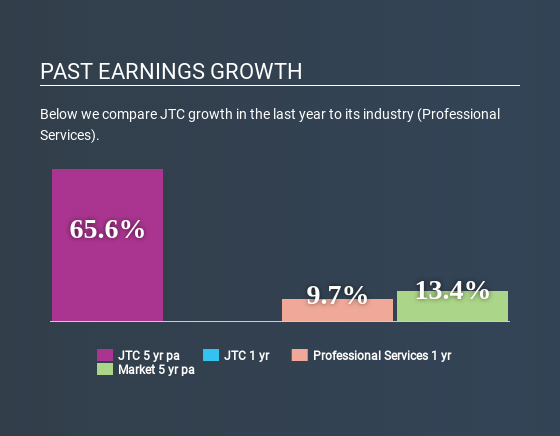JTC PLC's (LON:JTC) Stock's On An Uptrend: Are Strong Financials Guiding The Market?

JTC's's (LON:JTC) stock is up by a considerable 14% over the past three months. Given the company's impressive performance, we decided to study its financial indicators more closely as a company's financial health over the long-term usually dictates market outcomes. Particularly, we will be paying attention to JTC's ROE today.
Return on equity or ROE is a key measure used to assess how efficiently a company's management is utilizing the company's capital. In simpler terms, it measures the profitability of a company in relation to shareholder's equity.
See our latest analysis for JTC
How Is ROE Calculated?
ROE can be calculated by using the formula:
Return on Equity = Net Profit (from continuing operations) ÷ Shareholders' Equity
So, based on the above formula, the ROE for JTC is:
13% = UK£17m ÷ UK£129m (Based on the trailing twelve months to December 2019).
The 'return' is the amount earned after tax over the last twelve months. Another way to think of that is that for every £1 worth of equity, the company was able to earn £0.13 in profit.
What Has ROE Got To Do With Earnings Growth?
Thus far, we have learnt that ROE measures how efficiently a company is generating its profits. Depending on how much of these profits the company reinvests or "retains", and how effectively it does so, we are then able to assess a company’s earnings growth potential. Generally speaking, other things being equal, firms with a high return on equity and profit retention, have a higher growth rate than firms that don’t share these attributes.
JTC's Earnings Growth And 13% ROE
At first glance, JTC seems to have a decent ROE. Be that as it may, the company's ROE is still quite lower than the industry average of 19%. Still, we can see that JTC has seen a remarkable net income growth of 66% over the past five years. We reckon that there could be other factors at play here. Such as - high earnings retention or an efficient management in place. However, not to forget, the company does have a decent ROE to begin with, just that it is lower than the industry average. So this also does lend some color to the high earnings growth seen by the company.
As a next step, we compared JTC's net income growth with the industry, and pleasingly, we found that the growth seen by the company is higher than the average industry growth of 14%.
Earnings growth is a huge factor in stock valuation. What investors need to determine next is if the expected earnings growth, or the lack of it, is already built into the share price. Doing so will help them establish if the stock's future looks promising or ominous. What is JTC worth today? The intrinsic value infographic in our free research report helps visualize whether JTC is currently mispriced by the market.
Is JTC Using Its Retained Earnings Effectively?
JTC's three-year median payout ratio to shareholders is 12%, which is quite low. This implies that the company is retaining 88% of its profits. This suggests that the management is reinvesting most of the profits to grow the business as evidenced by the growth seen by the company.
Along with seeing a growth in earnings, JTC only recently started paying dividends. Its quite possible that the company was looking to impress its shareholders. Looking at the current analyst consensus data, we can see that the company's future payout ratio is expected to rise to 25% over the next three years. Still, forecasts suggest that JTC's future ROE will rise to 17% even though the the company's payout ratio is expected to rise. We presume that there could some other characteristics of the business that could be driving the anticipated growth in the company's ROE.
Summary
In total, we are pretty happy with JTC's performance. Specifically, we like that it has been reinvesting a high portion of its profits at a moderate rate of return, resulting in earnings expansion. Having said that, the company's earnings growth is expected to slow down, as forecasted in the current analyst estimates. To know more about the latest analysts predictions for the company, check out this visualization of analyst forecasts for the company.
This article by Simply Wall St is general in nature. It does not constitute a recommendation to buy or sell any stock, and does not take account of your objectives, or your financial situation. We aim to bring you long-term focused analysis driven by fundamental data. Note that our analysis may not factor in the latest price-sensitive company announcements or qualitative material. Simply Wall St has no position in any stocks mentioned.
Have feedback on this article? Concerned about the content? Get in touch with us directly. Alternatively, email editorial-team@simplywallst.com.

 Yahoo News
Yahoo News 

